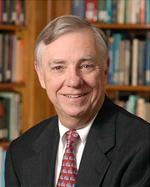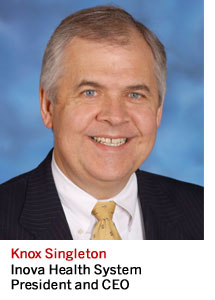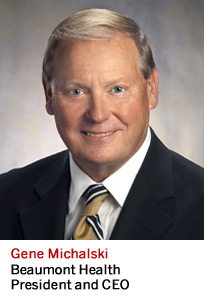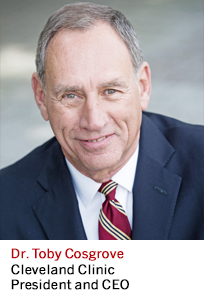This interview with Joel Allison, CEO of Baylor Scott & White Health, and Bob Pryor, President and CMO at Baylor Scott & White Health, was conducted by Eric Larsen, managing partner, and Tom Cassels, executive director, and condensed by Dan Diamond, executive editor.
This is the first part of a two-part interview.
Question: This is clearly a vocation for you two, not a job. Is that right? Tell me about how you found yourselves on this path.
Joel Allison: When I was a senior in college, it always felt like I was being called to some type of ministry, but I wasn't sure what type.
About that time, I was taking a course in photojournalism, and had to do a paper, take pictures, and write a story. And I did it on a day in the life of a medical resident—that's what my wife's brother was at the time. So I spent the weekend with him. He was on call in the emergency room on a Saturday night. And there's nothing like being in a public hospital on Saturday night in the trauma center.
That was really my first experience in a hospital. I'd only spent one night in a hospital in my whole life—I wasn't even born in a hospital. I was just fascinated and the hospital environment really excited me.
Later on that year, a group of doctors in Uvalde, Texas, invited my wife's brother to interview to join their practice. My wife and I were invited along and spent the day touring Uvalde.
We were touring the city, and the clinic, and met the doctors, and they took us to the hospital. When we went through the administrative area, they said, "We just hired a new young administrator. He was going into the ministry, but we talked to him about the ministry of healing, and asked him to consider going to Trinity and get his master's."
So we talked a lot about it on the drive home. Monday, back in Waco, I called the administrator at Hillcrest Baptist Hospital and asked him about his role, and about health care administration.
And he talked about the ministry of healing and the number of faith-based hospitals like Baptist hospitals, Methodist hospitals, Catholic hospitals, Presbyterian hospitals. He shared that it was through churches that many hospitals were begun throughout the United States.
And I thought, "Well, maybe this is the way the Lord is leading me."
I looked at the possible programs; Trinity in San Antonio, Duke, Northwestern, Minnesota and St. Louis. So I said, "Lord, if this is what you want me to do for my life’s work, I'm just going to apply to Trinity, and if I get accepted, I know this is the path for me." And I was blessed and fortunate enough to get accepted. As they say, the rest is history.
Bob Pryor: For me, I never really seriously considered anything else.
When I was in high school in Temple, Texas, I got the opportunity to work at Scott & White. I was the after-hours diener for the pathology department—I'd go at midnight and help with the autopsies, and the pathologists took a real interest in me.
I did that for a few years, and got really interested. That's when I thought to myself, "You know, this is what I'm going to do."
I went to Baylor, and did pre-med; I went to medical school, and got interested in pediatrics. I went into pediatric critical care, and did 20 years in the ICU, day and night.
One of the ways you get to really know a hospital is to be there at night. It's a whole different [animal]. I really felt like I got to understand the workings of a hospital.
But after 20 years, one day I just got burned out. I got on the elevator and said, "I'm going to work." I got off the elevator and said, "I don't want to do this anymore."
It wasn't until later when I realized why I burned out. It's because everything's so busy when you take care of 30 dying children. You never have enough time to sit and assimilate the death of a child. And it happens over and over and over again. But I didn't realize that's why I was feeling that way at the time.
Meanwhile, I got the opportunity to leave and go into administrative medicine at Catholic Healthcare West in Phoenix. I helped rebuild their pediatric program and after two years, I became the CMO for all of it. For the adult side, too.
But as I was becoming an administrator, I said to myself, if I really want to do this, I need a real business education. I'd gone to a Johns Hopkins business and medicine program, and there were a lot of doctors trying to learn business. But I'm not sure how serious they were about learning business.
So I went to Arizona State, and became a full-time student. I got an MBA. It was an incredible two years—at the end of it, I told my wife, "Well, that wasn't too bad." She said, "I haven't seen you in two years."
Q: Was she happy for you?
Pryor: She was happy to have me back.
Eventually, I got a call from a headhunter, and she said, "I want to tell you about an opportunity in Texas. It's a CMO position in a small town in Texas. Listen to me before you say no."
And almost immediately, I realized she was talking about Scott & White Hospital -- where my interest in health care began.
So, full circle, I came back and became a CMO. And then I got to be the COO and CMO, and then became the CEO.
You know, I had a very fulfilling 20-year career as a researcher, a teacher, and a clinician. I'm fortunate to have a second career.
Merger discussions
Q: One of the biggest stories in health care the past several years has been the rise of super-systems like yours—the combination of Baylor and Scott & White, two phenomenally successful health care organizations on their own. When did you two know that you wanted to find a partner?
Allison: When I was leading Baylor, I already had a relationship with Bob at Scott & White. We had spent time together through the Health Care Coalition of Texas. His passion and values were so aligned with where I was, and where Baylor was.
Pryor: It's more than a business relationship. It's a close friendship.
And we started talking about how could we transform health care from what we're doing today into where we could preserve and restore health, and not just take care of sick people.
Allison: It came down to a key question: What's the future of this industry?
We were having breakfast before a board meeting of the Health Care Coalition of Texas. We kept finding that our doctors had been working very well together on best practices, improved outcomes, improved quality.
We wanted to know more about how we could tie that physician work to how we were reducing costs and at the same time improve quality and access.
And we don't even remember which one of us actually said it. But at that breakfast, we asked, "What if we did it together?"
And we just went ahead and merged, and really looked at this whole concept of improvement of health, and increasing access. And both of us had the vision of population health management as the future.
Q: It couldn't have been that simple.
Pryor: We had it worked out in five minutes.
Allison: We thought, this is good. This is the right thing to do. So we said, "Let's go back and talk to our board chairs, and get them excited, too."
That didn't go well.
Q: That took more than 10 minutes?
Pryor: My chairman was not as enthusiastic as I was. He really did not think it was particularly a good idea.
Allison: My first conversation was similar. The board said we're doing great. We have plenty of opportunities here. Why get involved in a merger? But when we got back together, we decided that it was still worth having the conversation. And fortunately, our boards did, too.
Because of our bylaws and because of our normal rotation cycle, we had a change in board chairs and the conversation between the CEOs and the chairs continued. The interesting thing was that the two chairs and the two CEOs were all Baylor University graduates.
Pryor: The thing that got us back on track is the incredible trust that all four of us had in each other. The two chairs had served together as regents at Baylor University. They already had a relationship.
And that trust is something that you don't always see. But I think it was the trust that kept us on the right track.
At the time, I wasn't thinking about size. I was thinking about how we continue to grow to meet the needs of our communities.
Q: How did you bring coherence to the leadership teams beneath you? How did you deputize your staff to get this thing done?
Allison: After the decision was made, we had a mandate from the board: We're going to be one.
We're not two organizations under a holding company. We're an operating company.
And with that mandate, we started putting the teams together.
It was pretty clear that people on board early were going to be fine. If there were a few not on board who were creating an obstacle to our success, they would not last long in the organization.
Quite frankly, both management teams were very much in favor of this, even before the board. Management actually did a white paper for the board, to say why the merger made sense.
But I'll be candid: We've lost some people because this just wasn't for them. And that's fine. It's not for everybody. And you've got to understand the model. You've got to understand where we're headed.
But for the most part, our [managers] really have the values and vision of where we're going.
Pryor: This is one of the more incredible things. After we merged, we got together for a new mission statement. And I've been in a lot of mission statement formative meetings—they go on, and on, and on. People tweak a word here, they revise a word there.
We did it in under an hour. I mean, it was that easy. Mission, vision, values were alike.
Q: We've done a lot of profiling of M&A activities, and they all succeed or fail for that same foundational reason—cultural alignment or misalignment. It sounds like it was a series of providences, but the fact is the two organizations were aligned. It fit across the level.
Allison: Remember, we've had a relationship for a long time. There's also plenty of overlap on the physicians' side, given where [our] doctors trained. They knew each other.
And we were the only two systems in Texas that are members of the High Value Health Care Collaborative. So we've had physicians working together for some time.
But at the end of the day, it's the fact that you've had relationships and you've trusted those people.
Q: I have to ask a difficult question. When two large organizations like yours merge, how do you shake out questions of leadership?
Pryor: The reason to get the merger wasn't to get bigger. The reason was what we saw as complementary strengths. Of course, there were some weaknesses, too.
But when you start from trust, you can work through the weaknesses and accentuate the strengths in a real easy manner.
For most organizations, one of the most challenging conversations is often around leadership. That's not what we had here. At one meeting, somebody said, "Well, you know, when you have two CEOs, most of the time either both CEOs leave, or they can't do this."
And I replied, "When you have a seasoned CEO on one hand, and you have a doctor who's been a CEO for two years on the other, you know, it's a no- brainer."
Allison: That's being very gracious. When we presented this plan to the board, we had two good CEOs sitting in front of them, we believed.
And I'd been working on a succession plan for a couple of years. The board knew this. That's why I told them, "This is not about me. This is about the future of health care.
I want the board to feel good about this, because I can step out tomorrow. I'll stay one day, three days, whatever is appropriate. But I truly believe in this, and I believe Scott & White is the perfect partner because of their commitment to patient care."
It just so happened Bob jumped in early in the conversation and said, "I want to tell you now: I want Joel to be CEO. And I'll be President, COO and CMO."
Planning for the future
Q: Following the merger, how did you set the course for your new organization?
Allison: Bob and I had messaged all along: There's a Scott & White way of doing things. There's a Baylor Health Care System way. Maybe now that we're together, there's a third way that's even better.
To me, that's what the synergy is. You've got folks coming together who are committed to our mission.
We have what we call four non-negotiables that we constantly talk about. Put the patient first in everything that you do. Stay true to your mission. Live your values. And do the right thing for the right reason.
So the teams began to build our integration model on these principles.
But it goes back to what that No. 1 is: You've got to do it around the patient. And I think that's what makes people excited.
We're doing this around the fact that we're making it better for the patient and the populations and the communities that we're serving. And if we keep focused on that, why we're doing it, the how becomes the support, allocating the resources, and then staying very committed to the vision and the mission and the values.
Pryor: We were close enough friends that there haven't been any surprises. Zero surprises. And Joel is an amazing coach—he coaches the whole team.
Everybody is a specialist player, but the team works together because Joel coaches everyone to have this synergy.
I've been in meetings where they say, "Describe the best team you've ever been on." And I say, "Well, we're on it right now." Because the team right now is accomplishing things that we couldn't have accomplished alone.
Q: Can you offer an example?
Pryor: We originally thought clinical integration would take the longest. Either right before or right after the merger, we got all the executives together. And it came out that everyone thought integrating the doctors was going to take forever.
So here's the big surprise: Clinical integration is probably five years ahead of schedule.
By Day 300, we were already templating how the departments were working together for the benefit of patients, standardizing procedures, standardizing equipment, standardizing purchasing, and making sure that we were doing everything the right way.
Here's the real surprise: I had to pull the reins back, because the doctors were wanting to do this so rapidly. I had to tell them, "This is great stuff, but we've got to do it a little slower."
Allison: The reason we moved clinical integration so far is because of Bob. His leadership has been phenomenal in working with the physicians.
Q: There are a couple of themes in what Baylor Scott & White has been able to do. One is the speed of progress you've been able to make on the clinical side. How critical is it for you to engage this mission, to have that financing mechanism? And how fast do you think you can make your own news by shifting the way that health is financed?
Allison: We think we can bridge this because of the Baylor Scott & White Quality Alliance. That's our version of an ACO. It's very innovative.
It also now becomes the preferred network for the health plan. The first population we put in the Quality Alliance was our own employees and their dependents who were self-insured through legacy Baylor.
The first year's results are phenomenal. We saved $14 million. We've reduced admissions and readmissions.
Now we're working with payers and employers who say, "We want to see that same value." And they're starting to recognize what we're trying to change the model of financing while we bridge the move from volume to value.
We've always talked about how we [go] from fee-for-service to paying for value and performance without falling into the crevice.
We believe we have the mechanism in place to be able to do that because we can now work with payers and employers to share in the savings that can be achieved through the Quality Alliance.
Q: What's the secret sauce behind these initiatives? I imagine you could point to several factors.
Allison: We have very strong physician leadership and engagement. And one of the great things that the Quality Alliance has allowed us to do that resonates well with physicians is we have data for them to use in caring for their patients.
By being digitally connected through their EHRs, through our HIE, through services like Explorys and Crimson, physicians can get relevant and useful data. Physicians work very well with good, solid data that can be turned into information and is actionable.
As we grow the Quality Alliance and gain more covered lives, physicians will want to join the Alliance to have access to good data and to patients.
We're trying strategically to give them the tools and set up a structure that will be a win for the providers, payers and patients.
And this is why we have physicians leading the Quality Alliance, and people who work well with physicians. Let this be a physician-led and physician-driven initiative.
Pryor: Physicians will align around quality care if you give them the opportunity. You have to be able to say, "I'm going to give you the data that you need to make your practice better. I'm going to give you the knowledge that's going to make you a better physician."
And here's the deal we give to doctors. Being part of this means that you put your data in, we give you the data out, and when we see areas [for improvement], we're going to come talk to you about it. And when they agree to that, and they move forward, then things start aligning.
It doesn't matter where a doctor's paycheck comes from. This is where so many people get confused: The paycheck never causes a doctor to be engaged.
This isn't for everybody. There are some physicians that view entrepreneurship as above their calling. But we have a cadre of physicians who come to work every day to make their practice better, to make the community better.
This is part one of a two-part interview.
Get more lessons from the C-suite
See the Daily Briefing's archive of must-read interviews with other top hospital and health system leaders, including:
 How an ACO champion—now a health system CEO—plans to put one in every market
How an ACO champion—now a health system CEO—plans to put one in every market
Richard Gilfillan explains how he viewed health care delivery as the first head of the Center for Medicare and Medicaid Innovation—and how that changed when he became the CEO of Trinity Health. Read our interview with Richard.
How an English major became a hospital CEO at age 29
In a Q&A with the Daily Briefing, Sandra Bruce explains what she's learned in her decades as a hospital CEO, how two systems overcome bumps in the road to become Presence Health, and what it means to "Lean In" in health care. Read our interview with Sandra.
 Why one Baby Boomer CEO thinks Millennials have 'superior' leadership potential
Why one Baby Boomer CEO thinks Millennials have 'superior' leadership potential
Knox Singleton explains what it's like to lead the same system for 30 years, how a hospital can successfully "humanize" its executives, and his strategy behind shifting Inova's brand.
 How to prove a boss wrong when he thinks you're the second choice? Do what this CEO did.
How to prove a boss wrong when he thinks you're the second choice? Do what this CEO did.
Today, Gene Michalski is the first CEO of Beaumont Health, a newly formed $4 billion health system. But almost 40 years ago, when Michalski applied for the position that launched his career…he was originally the second choice. In an interview with the Daily Briefing, Michalski shares his secret to convincing a wary leader to hire him, how it influenced his own management style, and how he sees the industry. Read our interview with Gene.
 Cleveland Clinic CEO's single best tip on building a career: 'Shamelessly steal.'
Cleveland Clinic CEO's single best tip on building a career: 'Shamelessly steal.'
Toby Cosgrove explains how—despite barely getting into med school—he's now the head of the Cleveland Clinic, how he sees the industry, and how one tactic is key to his management success. Read our interview with Toby.
Most staff aren't naturally great leaders, but studies show that leadership and management can be taught. Use our Leadership Competency Diagnostic to help your managers further develop their strengths and focus on opportunities for improvement.
And it's never too early to start grooming a great manager. See our Succession Management Implementation Guide to ensure you deliberately chose your future leaders—don’t let circumstances choose them for you.
Don't miss out on the latest Advisory Board insights
Create your free account to access 2 resources each month, including the latest research and webinars.
Want access without creating an account?
You have 2 free members-only resources remaining this month remaining this month.
1 free members-only resources remaining this month
1 free members-only resources remaining this month
You've reached your limit of free monthly insights
Become a member to access all of Advisory Board's resources, events, and experts
Never miss out on the latest innovative health care content tailored to you.
Benefits include:
You've reached your limit of free monthly insights

